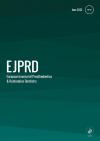European Journal of Prosthodontics and Restorative Dentistry
Accuracy of Removable Partial Denture Frameworks Fabricated Using Conventional and Digital Technologies
Abstract
This study analyzed the fit accuracy of the removable partial denture (RPD) metal frameworks produced using digital and conventional manufacturing technologies. Mandibular RPD metal frameworks (N=15, n=3 per group) were fabricated on a representative clinical case. RPDs were fabricated using one of the following manufacturing procedures: a) conventional lost-wax casting technique (C-LW), b) conventional casting of milled sacrificial patterns (C-M), c) conventional casting of printed sacrificial patterns (C-P), d) selective laser melting (SLM), e) direct metal laser sintering (DMLS) technologies. The fit accuracy of RPD frameworks was analyzed by fabricating replicas with silicone registration material and measuring with a digital microscope. A total of 11 sites
and 29 areas in the RPD metal frameworks were considered for the accuracy measurements (μm). Data were statistically analyzed using Wilcoxon signed rank and Friedman test (α=0.05). Before finishing and polishing, C-M method presented overall significantly better (P<.001) fit accuracy (118 μm) than those of other methods (195-265 μm). After finishing and polishing, C-M method showed overall significantly better (P<.033) fit accuracy (205.7 μm) than C-LW and SLM methods (285.7 μm; 249 μm) and comparable fit accuracy to that of C-P and DMLS methods. Accuracy at the minor and major connector areas of RPDs were affected from the manufacturing technologies. Clinical Implications: When accuracy of RPDs are considered, digital technologies tested presented similar results to those of conventional manufacturing method except for minor and major connector areas which necessitates further improvement.Keywords
3D Printing
Removable Partial Dentures
Additive Manufacturing Technologies
Selective Laser-Melting
Direct Metal Laser Sintering
Metal Framework
Authors
Elena Muehlemann, Mutlu Özcan
Articles from this issue
 Free Access
Free Access No Access
No Access Full Access
Full Access


